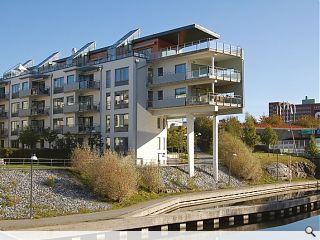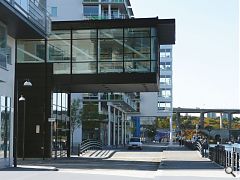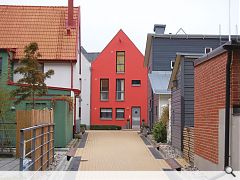Swede success
7 Oct 2010
Smith Scott Mullan Director Alistair Scott knows a thing or two about the seaside having been involved in waterfront regeneration projects from the Forth to the Irish Sea. So why have the likes of Edinburgh been all at sea whilst Malmo has been making waves? Scott travelled to Sweden to get some tips from our Nordic neighbour.
Scotland has a multitude of waterfront regeneration projects, from Leith to Orkney and all along the Clyde. That heady mix of water and available development land has spawned a rash of proposals. Some are good and some less so, but most have a similarity of approach and show the limitation of the system they are produced under. Parallels of climate and culture have always made our Nordic neighbours reference points in collaborations and such comparisons can only help develop our aspirations.
Hammarby Sjokstadt
Stockholm is a city of islands, currently expanding through hi-tech and knowledge-based industries, directed by a strong political, academic and industrial consensus. Its bid for the 2004 Olympics (Athens actually won it) was the catalyst to create a new urban quarter on derelict industrial land to the south of the city. Like all Scandinavian developments the aspirations are strongly linked to national objectives and the process followed the familiar European model of setting firm political objectives, followed by comprehensive master planning and the creation of integrated and highly effective delivery vehicles.
As a place, Hammarby offers a highly attractive lifestyle. It is a large development and has created a new community where 26,000 people live and 10,000 work in a lakeside setting, where great care has been taken to maximise access and views of the water. The basic component is an urban block of six storeys, organised around wide streets in typical European fashion. All the apartments have balconies, all the buildings have lifts and garden areas provide ample green space for bringing up families. This is a high density, inner-city development but every element of open space has been highly designed for people. Cars are generally stored underground and their use appears reasonably limited due to good public transport.
Other facilities are integrated into the general fabric. Shops are within apartment buildings. Government agencies have the same attitude and no one seems to see a problem with a primary school sharing a building with shops and apartments.
Concern with linking sustainability to lifestyle informs all parts of the project. Sweden has, for years, embraced comprehensive environmental policies far in advance of the UK. A manifestation of this is that Stockholm is serviced almost entirely by a district heating system powered by four power stations, mainly using waste products. Water is metered, initiatives to encourage sustainable travel are abundant and the buses are run on bio-gas. Interestingly, one of the initial objectives was to clearly define Hammarby as not being an 'eco village'. It was specifically conceived as being a 'normal' piece of city, where residents could live a normal lifestyle and where contributions to environmentalism did not require major lifestyle changes, yet where concern for the environment provided a common objective that helped bind the community together.
Of particular interest was how all this had been achieved. Sweden has general political commitment to social equality and environmentalism at a national level and a consensual approach to issues such as planning, transport provision and district heating systems at a local level. These attributes are now highly embedded in the Swedish delivery system, in stark contrast to the British situation, where almost every decision becomes a point of funding debate and the creation of integrated infrastructure a low priority. This theme of integration runs through the entire process. The local authority was central to the development, setting the aspirations and producing a design vision which gave a physical view of the eventual development. City control over public transport, power and water delivery allowed these services to be both forward funded and easily integrated. Although there were constant discussions with private sector partners, their engagement was strictly within an agreed masterplan. There were 30 individual developers involved, all of whom have appeared to stick to the overall quality aspirations.
Referring to Hammarby as regeneration is not strictly accurate, as it does not attempt to revive a declining community, but creates a new integrated urban neighbourhood. In Britain we seem to have created the position where our public agencies focus on improving existing neighbourhoods and our private sector focuses on new independent developments. Hammarby is a bit like Scotland setting the objective of building a new version of the Victorian expansion suburbs such as perhaps Comely Bank in Edinburgh or Woodlands in Glasgow.
We had to ask ourselves the question 'is there anything that scottish designers could have contributed?' While all of us were really impressed by Hammarby, it has that very clean, organised but, slightly predictable quality that you find in much contemporary Scandinavian, or Germanic development. It lacks a certain quality of contrast, or the eccentric move, which seems to be the domain of the British, the French and the Italians. It is a hard thing to define, but if we could adopt their basic structures and still infuse our developments with this elusive quality, we would be on to a serious winner.
Vastra Hamnen, Malmo
Malmo is a completely different type of city from Stockholm, being smaller and with an industrial heritage. It has a substantial immigrant population and is renowned for turning its post-industrial decline into a dynamic, lively and yet sophisticated city. Conceived around a European Housing Exposition, the Vastra Hamnen (it means Western Harbour) is situated in a former industrial area and provides a new seafront for the city.
As a development it is much more diverse than Hammarby and is essentially a 'village' of two and three storey housing surrounded by a 'wall' of larger apartment blocks, which shelter it from the sea and create a promenade. It also has the bizarre feature of Sweden's tallest building, a mixed commercial and residential tower by Santiago Calatrava. Intended as an icon to mark the waterfront, it is an unnecessary element as the development has a strong enough identity itself.
We visited on a cold, wet and windy winter day, which allowed us a different perspective from the carefully manicured publicity photographs that we generally see. However, it is still a highly impressive place and attracts the city residents to the sea, even on bad days. The mix of buildings is particularly impressive, allowing for a community of all ages and types. The complex and tight streets within the 'village' area give a real sense of richness, with the larger seafront buildings providing the sense of grandeur.
The challenge
Developments such as these send out a challenge to all involved, but particularly to Scottish politicians and clients. Although impressive, these developments are not unique and a similar quality of place-making can be found from Helsinki to Amsterdam. We are making a number of brave attempts and many current policies aim in this direction. However, we need serious political champions and to have confidence in long term planning. If we could just focus on a few simple but elusive issues, such as good infrastructure and quality of place, perhaps Scotland could create a leading example of a new waterfront, a place people would visit to see how the best is produced?
Let's give it our best shot.
|
|
Read next: Fred, Frank & Will
Read previous: Hole story
Back to October 2010
Browse Features Archive
Search
News
For more news from the industry visit our News section.
Features & Reports
For more information from the industry visit our Features & Reports section.





